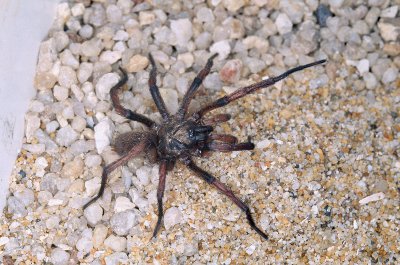Melbourne Trapdoor Spider
Category: Arachnida Spider

Facts about Melbourne Trapdoor Spiders, "Scientific name for Melbourne Trapdoor Spider is Stanwellia grisea". The Melbourne Trapdoor refers to a large robust spider with a brown cephalothorax and legs. Its abdomen is usually paler a dark mottled pattern on the upper surface. The male Melbourne trapdoor spiders sometimes have golden hairs on their cephalothorax, and they are smaller with longer legs than the females. It is important to note that both females and males Melbourne trapdoor spiders dig silk lined burrows in soft soil up to (40 cm) deep and there often silk strands trip lines radiating from around the burrow’s entrance.
The male Melbourne trapdoor spider has a body length of twenty five millimeters while the female is about ten millimeters longer. This is basically a common ground dwelling spider which is usually encountered by gardeners moving rocks or digging soil. Generally, the Melbourne Trapdoor Spider mainly feed at night waiting at the entrance of the burrow to ambush any passing insects. For this type of spider to breed, the mature male Melbourne Trapdoor Spider leaves the burrow and goes searching for the female spider in late winter and autumn. The wandering male Melbourne trapdoor spider may fall into swimming pools or wander into houses. The Melbourne trapdoor spider can live from five to twenty years.
Melbourne Trapdoor Spiders have oversize brains.
In the Melbourne Trapdoor Spider the oxygen is bound to "hemocyanin" a copper-based protein that turns their blood blue, a molecule that contains copper rather than iron. Iron-based hemoglobin in red blood cells turns the blood red
Melbourne Trapdoor Spiders have two body parts, the front part of the body is called the Cephalothorax-(the thorax and fused head of spiders). Also on this part of the body is the Melbourne Trapdoor Spider’s gland that makes the poison and the stomach, fangs, mouth, legs, eyes and brain. Melbourne Trapdoor Spiders also have these tiny little leg-type things called (pedipalps) that are next to the fangs. They are used to hold food while the spider bites it. The next part of the Melbourne Trapdoor Spiders body is the abdomen and the abdomens back end is where there is the spinnerets and where the silk producing glands are located.
The Melbourne trapdoor spider has large fangs which inflict a deep painful wound when bitten in rare occasions. However, there are no serious medical problems proven to be caused by the venom of the Melbourne Trapdoor Spider, even though the bite can result in a reaction which may include swelling, itching, burning or redness at the site of bite. The Melbourne Trapdoor Spider’s tail has two large appendages which are spinneret that provides base for opening of the silk glands. Melbourne trapdoor spiders are usually thought to be Sydney funnel web spiders due to its color, large fangs and size.
Spiders belong to a group of animals called "arachnids", mites and Scorpions and a tick is also in the arachnid family. An Arachnids is a creature with eight legs, two body parts, no antennae or wings and are not able to chew on food. Spiders are not insects because insects have three main body parts and six legs and most insects have wings.
The Arachnids are even in a larger group of animals called "arthropods" an invertebrate animal of the large phylum Arthropoda, which also include spiders, crustaceans and insects. They are the largest group in the animal world, about 80% of all animals come from this group. There are over a million different species. There are more than 40,000 different types of spiders in the world.
The muscles in a Melbourne Trapdoor Spiders legs pull them inward, but the spider can't extend its legs outward. It will pump a watery liquid into its legs that pushes them out. A Melbourne Trapdoor Spider’s legs and body are covered with lots of hair and these hairs are water-repellent, which trap a thin layer of air around the body so the spiders body doesn't get wet. It allows them to float, this is how some spiders can survive under water for hours. A Melbourne Trapdoor Spider feels its prey with chemo sensitive hairs on its legs and than feels if the prey is edible. The leg hair picks up smells and vibrations from the air. There are at minimum, two small claws that are at the end of the legs. Each Melbourne Trapdoor Spiders leg has six joints, giving the spider 48 leg joints. The spider’s body has oil on it, so the spider doesn't stick to it’s own web.
A Melbourne Trapdoor Spiders stomach can only take liquids, so a spider needs to liquefy their food before they eat. They bite on their prey and empty its stomach liquids into the pray which turns it into a soup for them to drink.
A male Melbourne Trapdoor Spider has two appendages called "pedipalps" a sensory organ, instead of a penis, which is filled with sperm and insert by the male into the female Melbourne Trapdoor Spider’s reproductive opening.
Melbourne Trapdoor Spiders do not have a skeletons. They have a hard outer shell called an exoskeleton-(a rigid external covering for the body in some invertebrate animals). The exoskeleton is hard, so it can’t grow with the spider. The young Melbourne Trapdoor Spiders need to shed their exoskeleton. The spider has to climb out of the old shell through the cephalothorax. Once out, they must spread themselves out before the new exoskeleton will harden. Know they have some room to grow. They stop growing once they fill this shell.
Female Melbourne Trapdoor Spiders lay eggs on a bed of silk, which she creates right after mating. Once the female Melbourne Trapdoor Spider lays her eggs, she will than cover them with more silk.

 Back To Category Arachnida Spider
Back To Category Arachnida Spider